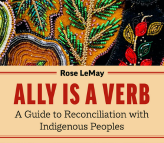When the Truth and Reconciliation Commission started to communicate and share the truths of the Indian Residential Schools in Canada, many were faced with new information, and the challenge to integrate that information into their worldview of what is Canada. We tend to have a positive worldview of the good in Canada, and the impact that Canada has had on the world. It’s difficult to re-access and find that the country did some pretty terrible things.
Building a more balanced view of Canada and the good and the bad, does not erase the good. It simply adds balance. A more balanced view of Canada does two things for us.
A more balanced view is more inclusive – it recognizes, respects and honours the life experience of Indigenous Canadians whose life experience may be very different from the average urban non-Indigenous Canadian.
A more balanced view enables us to learn from the past. A more balanced view which understands the rationale and intent behind Indian residential schools as assimilation and colonization based on a misguided belief in white supremacy – the more we know of history, the more able we are to not repeat history.
But now what? How do we do reconciliation?
Let’s think about this from a social change perspective. Malcolm Gladwell wrote The Tipping Point partly based on a social psychology experiment by Levanthal. The social psychology experiment was about the types of information that might influence an individual to change his/her behaviour and get a tetanus vaccination. Some individuals received stark warnings about tetanus, some gentle communication. But the short story was in this experiment, while individuals received all sorts of information about the reasons why such a vaccination is a good thing, only 3% of them actually went to go get the shot. Information alone didn’t make much of a difference at all.
Gladwell re-ran the experiment, and dramatically changed the results with almost 28% of individuals changing their behaviour and getting the vaccination. How? By adding a map of where to go get the vaccination – the “how to” part.
It’s very similar to the growing evidence about change management. People need to know enough information to care and people need to come to a decision point and decide they want to change or contribute to the solution. And then they need some simple first steps to do immediately.
Back to the topic of reconciliation. It’s more than knowledge It’s about people deciding to do things differently, a decision to change. And some simple things to start the journey.
We tend to talk about reconciliation as a “sea-change”, a new era, a systemic shift in Canada. I totally agree. But I believe it starts with people. Social change always starts with people making changes in themselves and in their circles of influence.
So reconciliation is both knowledge and action. In the Indigenous Cultural Competence workshop offered by the IRG, we build participants’ knowledge and understanding of history and the reasons why reconciliation is required. And then we facilitate a safe space for adults to think about the influence they have, and the opportunity to contribute on a daily basis towards reconciliation. We support the “how to” of reconciliation.
Many participants come of out the Indigenous Cultural Competence workshop committed to contributing to reconciliation, both professionally and personally.
The “how to” of reconciliation has many factors. For non-Indigenous Canadians, it’s about being an ally, and advocate for a different vision of Canada in which Indigenous peoples feel safe and welcomed. Be the gentle challenge function when others disparage Indigenous Canadians. Be the advocate for the inclusion of Indigenous voice, instead of others speaking for Indigenous. Stand up against racism when you see it, and stand up for Indigenous Canadian inclusion. Create space for Indigenous people, voice and knowledge. Encourage others to join you on the reconciliation journey. Continue to learn about the Indigenous communities around you, attend the public events. Sometimes the voice of the ally is heard loudly, even when the voice of the Indigenous cannot be heard. We need the voices of allies to do social change.
For Indigenous Canadians, it’s also about knowing history, and the complex impacts on self-identity and culture. The more we understand of the intent of colonization, the more we can let go of its tentacles of rules and shame, and rebuild a sense of Indigeneity based on our knowledge systems. We need the strength of Indigenous knowledge systems to do social change.
The “how to” of reconciliation starts with each one of us, challenging each other to dream bigger, to dream of full safety and inclusion of Indigenous Canadians. To stand up for each other, and to stand together for the strength of the circle.
Reconciliation is not an abstract philosophy. It is a practical daily choice we make, every day.
Yes, it starts small. Every social change starts small. And the successful social changes ripple change across more and more people, and the change speeds up, faster and faster. Be part of the change.
